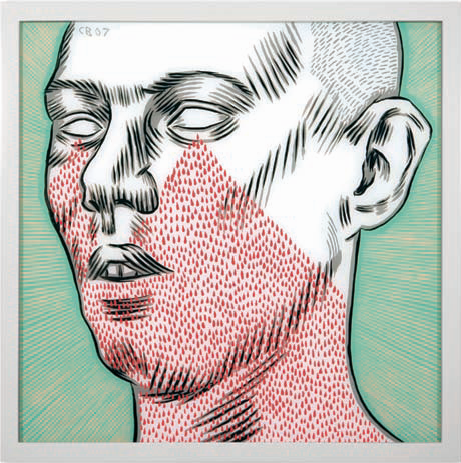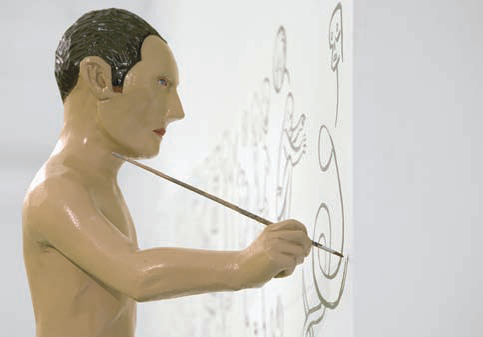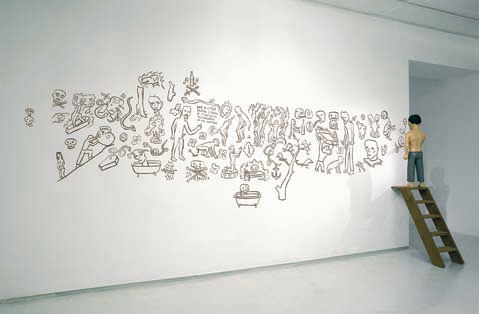In 1992, in those uneasy years between the release of Nelson Mandela from prison in 1990 and the first South African democratic election in 1994, Bitterkomix was born. This ribald, pornographic, angry adult comic book, still published at intervals, held up to public ridicule Afrikaner values and beliefs. The sense of betrayal among Afrikaners was felt all the more keenly because Bitterkomix was the brainchild of two sons of Afrikanerdom, Conrad Botes and Anton Kannemeyer, fellow lecturers at the conservative University of Stellenbosch.
The use of a sharp, black graphic line filled with flat color and the slashing frontal thematic attack on Afrikaner culture continued to direct Botes’s work as he left university and began his career as a professional artist, but his perspective has broadened and his angst has become nuanced.
Botes’s 2007 solo show, Satan’s Choir at the Gates of Heaven, at Michael Stevenson Contemporary in Cape Town, exemplified the artist’s eclectic style and his ability to work in a variety of media. His sculptures and paintings focused on the sense of loss of power and identity experienced by Afrikaners under the new ANC government.
A grid of nine paintings on glass, Weeping Zombies, featured in the show, addresses white male identity in post-apartheid South Africa. Botes describes his subjects as “people who are nonexistent or dead. People who feel they have no place anymore but they can’t leave, they are just stuck in a non-place, soaked in their own tears.” In Botes’s paintings the blood-colored tears seem to have become embedded in the flesh of the weepers, like ritualistic scarifications.
A key piece on the 2007 show was Autobiographer, a painted wooden sculpture of a man, head slightly bowed, staring down. The figure is, as Botes explains, “using his body as a surface to write things down and to record the contents of his head, the things he’s obsessed with”—thereby accepting responsibility, perhaps, for his own creations. The pen is held like a sword about to run him through.
Perhaps Botes’s most poignant piece to date is his Foreign Body (2007, page 170), painted directly on the wall with the addition of small round paintings on glass at the Center for Contemporary Culture, Barcelona, for a show titled Local Racism, Global Apartheid. South Africa as a Paradigm (2007). In Botes’s version of Michelangelo’s Pietà, the Madonna figure has been replaced by a grieving gorilla, that iconic and majestic beast hunted almost to extinction by man. In the penumbric lines that surround the seated pair, circular glass paintings portray burdened figures.
It is only in the sad and tender attitude of the gorilla/Madonna that Botes allows any hint of the redemptive to alleviate his dystopian view.

Weeping Zombies 2007
9 reverse glass paintings, enamel on glass
Each 60 x 60 cm
Image courtesy of the artist and the Michael Stevenson Gallery, Cape Town
Photographer: Mario Todeschini
© Conrad Botes

Weeping Zombies (detail) 2007
9 reverse glass paintings, enamel on glass
Each 60 x 60 cm
Image courtesy of the artist and the Michael Stevenson Gallery, Cape Town
Photographer: Mario Todeschini
© Conrad Botes

Autobiographer 2007
Enamel on jelutong, iroko
31 x 31 x 140 cm, including pedestal
Image courtesy of the artist and the Michael Stevenson Gallery, Cape Town
Photographer: Mario Todeschini
© Conrad Botes

Devil’s Dictionary 2007
Enamel on obeche, iroko
35 x 71 x 160 cm, including ladder
Installation dimensions variable
Image courtesy of the artist and the Michael Stevenson Gallery, Cape Town
Photographer: Mario Todeschini
© Conrad Botes

Devil’s Dictionary 2007
Enamel on obeche, iroko
35 x 71 x 160 cm, including ladder
Installation dimensions variable
Image courtesy of the artist and the Michael Stevenson Gallery, Cape Town
Photographer: Mario Todeschini
© Conrad Botes